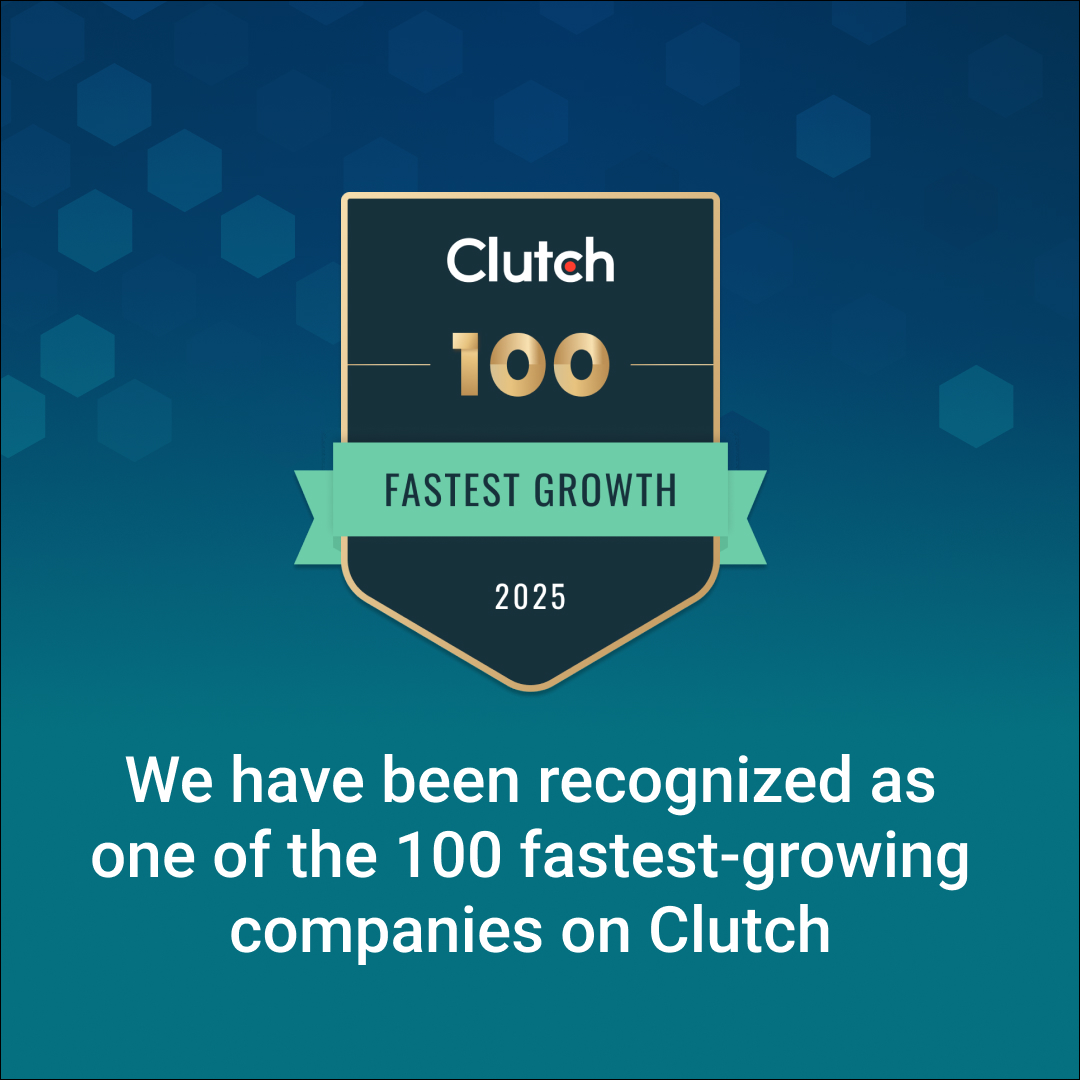Introduction
The automotive industry is undergoing a significant transformation, driven by the integration of Artificial Intelligence (AI) across various facets of vehicle design, manufacturing, and operation.
From enhancing driver safety to optimizing production processes, AI is at the forefront of this evolution.
This comprehensive guide explores the pivotal AI use cases reshaping the automotive landscape.
What is AI and Why Does It Matter in Automotive Industry?
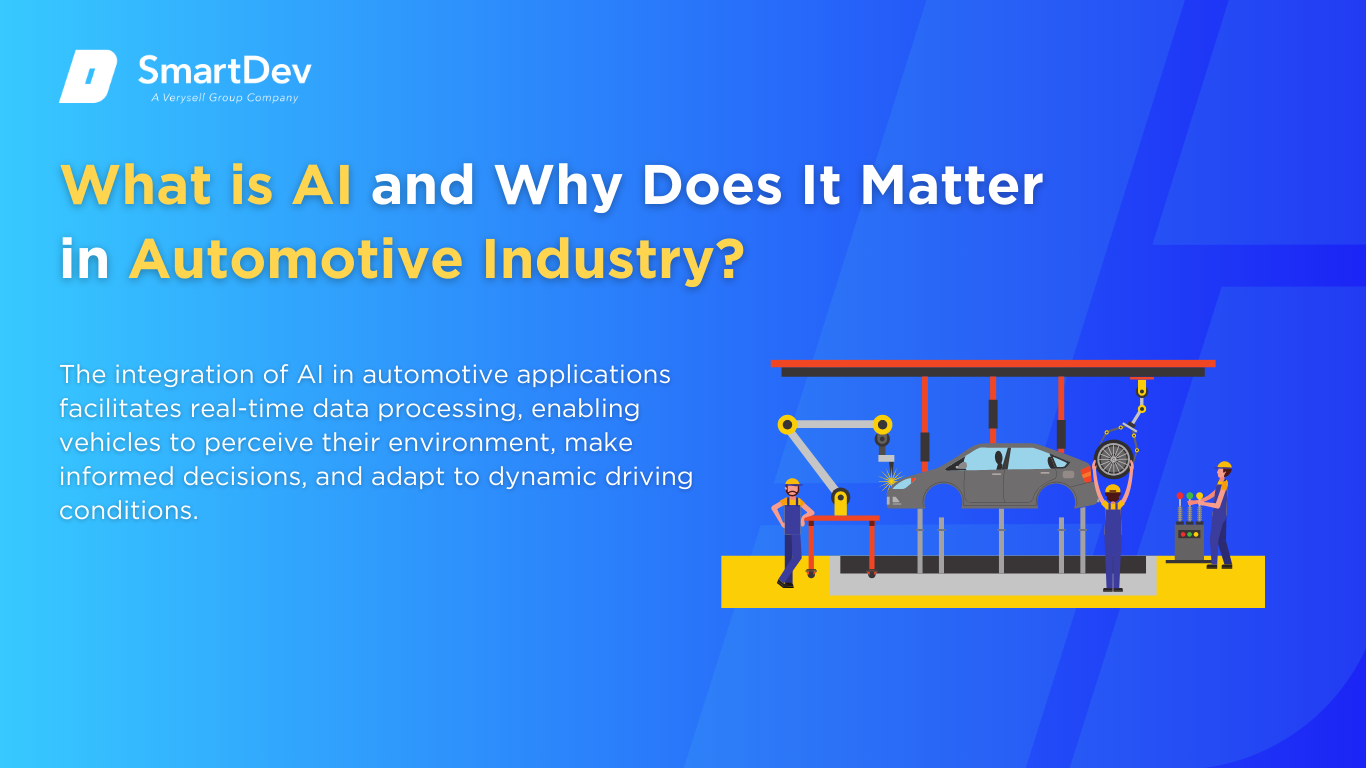
Definition of AI and Its Core Technologies
Artificial Intelligence (AI) encompasses computer systems capable of performing tasks that typically require human intelligence, such as learning, reasoning, and decision-making.
In the automotive context, AI technologies like machine learning, computer vision, and natural language processing are instrumental in developing autonomous vehicles, enhancing driver assistance systems, and streamlining manufacturing processes.
- Machine Learning (ML): Learns from data to enhance predictions and decisions.
- Natural Language Processing (NLP): Enables machines to interpret human language for maintenance logs or interactions.
- Computer Vision: Processes visual data for quality control and safety monitoring.
- Robotic Process Automation (RPA): Automates repetitive tasks to boost administrative efficiency.
- Edge AI: Processes data on-site for real-time factory decisions.
The integration of AI in automotive applications facilitates real-time data processing, enabling vehicles to perceive their environment, make informed decisions, and adapt to dynamic driving conditions.
This technological advancement is crucial for the development of safer, more efficient, and intelligent transportation systems.
Explore practical strategies to implement AI across design, manufacturing, and customer experience in 2025.
Check out our guide on How to Integrate AI into Your Business in 2025 to start transforming your automotive operations with intelligent, data-driven solutions today.
The Growing Role of AI in Transforming Automotive Industry
AI is revolutionizing vehicle manufacturing by introducing automation and precision in assembly lines.
For instance, AI-driven robots are employed for tasks like welding and painting, ensuring consistency and reducing human error.
Moreover, AI algorithms analyze production data to predict equipment failures, facilitating proactive maintenance and minimizing downtime.
In vehicle design, AI assists engineers by simulating various design scenarios, optimizing aerodynamics, and improving fuel efficiency.
Generative design algorithms can propose innovative structures that meet specific performance criteria, accelerating the development cycle and fostering innovation.
On the road, AI enhances the driving experience through advanced driver-assistance systems (ADAS).
Features like adaptive cruise control, lane-keeping assistance, and automatic emergency braking rely on AI to interpret sensor data and make split-second decisions, significantly improving road safety.
Key Statistics and Trends Highlighting AI Adoption in Automotive Industry
The adoption of AI in the automotive industry is accelerating.
According to a report by McKinsey, AI-enabled applications could generate up to $215 billion in value annually for the automotive sector by 2030.
This includes improvements in manufacturing efficiency, enhanced customer experiences, and the development of autonomous vehicles.
Furthermore, a study by Capgemini Research Institute indicates that 25% of automotive companies have already implemented AI at scale, with an additional 31% planning to do so within the next three years.
This trend underscores the industry’s commitment to leveraging AI for competitive advantage and operational excellence.
Business Benefits of AI in Automotive Industry
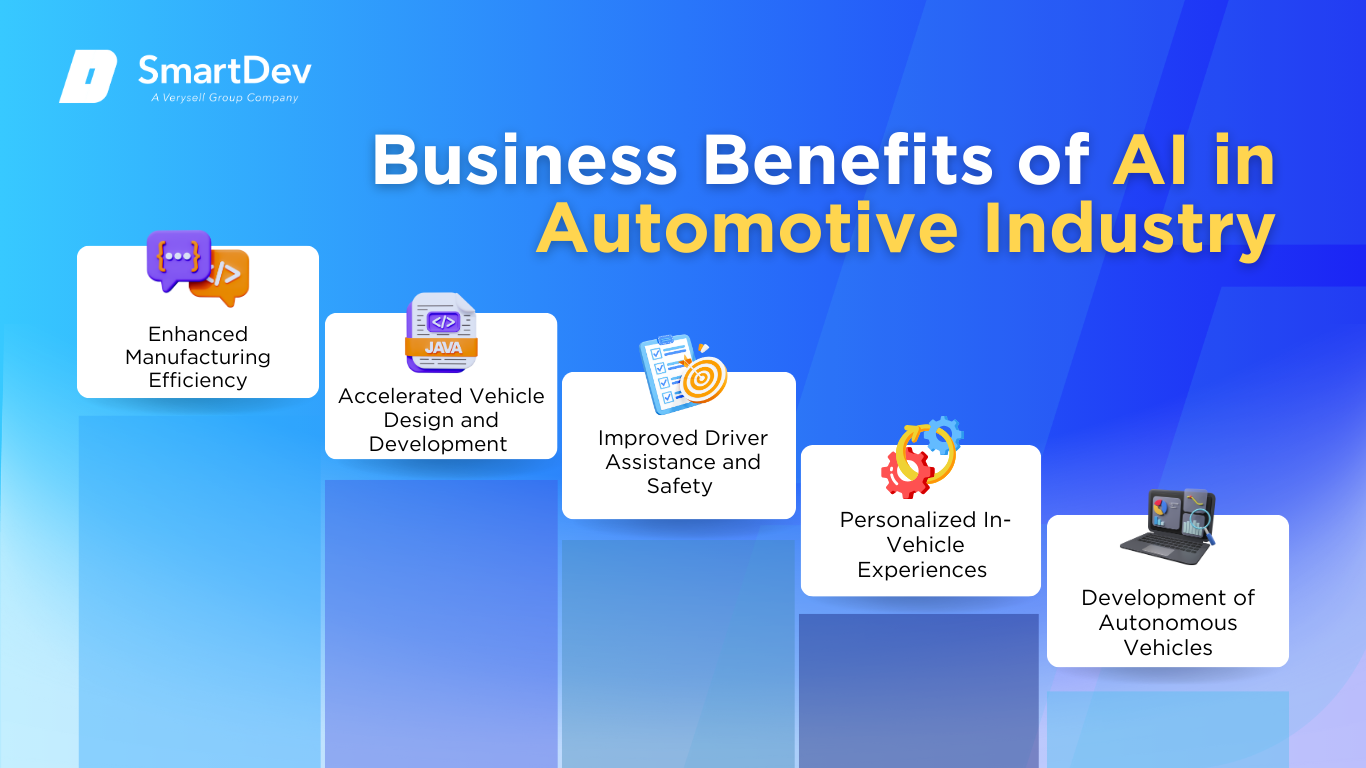
1. Enhanced Manufacturing Efficiency
AI optimizes manufacturing processes by enabling predictive maintenance and quality control.
By analyzing sensor data from machinery, AI systems can predict equipment failures before they occur, reducing unplanned downtime and maintenance costs.
Additionally, AI-powered vision systems inspect products for defects with greater accuracy than human inspectors, ensuring higher quality standards and reducing waste.
This leads to more efficient production lines and cost savings.
Check out our guide on AI Use Cases in Manufacturing to see how manufacturers are accelerating innovation and efficiency across the automotive value chain.
2. Accelerated Vehicle Design and Development
Incorporating AI into the design phase allows for rapid prototyping and testing of vehicle components.
AI algorithms can simulate various design configurations and predict their performance, enabling engineers to make data-driven decisions quickly.
This accelerates the development cycle, reduces the need for physical prototypes, and fosters innovation by exploring a broader range of design possibilities.
3. Improved Driver Assistance and Safety
AI enhances vehicle safety through advanced driver-assistance systems (ADAS).
These systems utilize AI to process data from cameras, radar, and other sensors to assist drivers in real-time.
Features such as automatic emergency braking, pedestrian detection, and lane departure warnings rely on AI to interpret complex driving environments, reducing the likelihood of accidents and improving overall road safety.
4. Personalized In-Vehicle Experiences
AI enables the personalization of in-vehicle experiences by learning driver preferences and behaviors.
Infotainment systems powered by AI can suggest music, adjust climate controls, and provide navigation assistance tailored to individual drivers.
This level of personalization enhances driver satisfaction and comfort, creating a more engaging and user-friendly driving experience.
5. Development of Autonomous Vehicles
AI is the cornerstone of autonomous vehicle development.
Self-driving cars rely on AI to process vast amounts of data from sensors and make real-time decisions.
Machine learning algorithms enable these vehicles to navigate complex environments, recognize objects, and respond to dynamic driving conditions.
The advancement of AI technologies is bringing fully autonomous vehicles closer to reality, promising to transform mobility and reduce traffic-related incidents.
Challenges Facing AI Adoption in Automotive Industry
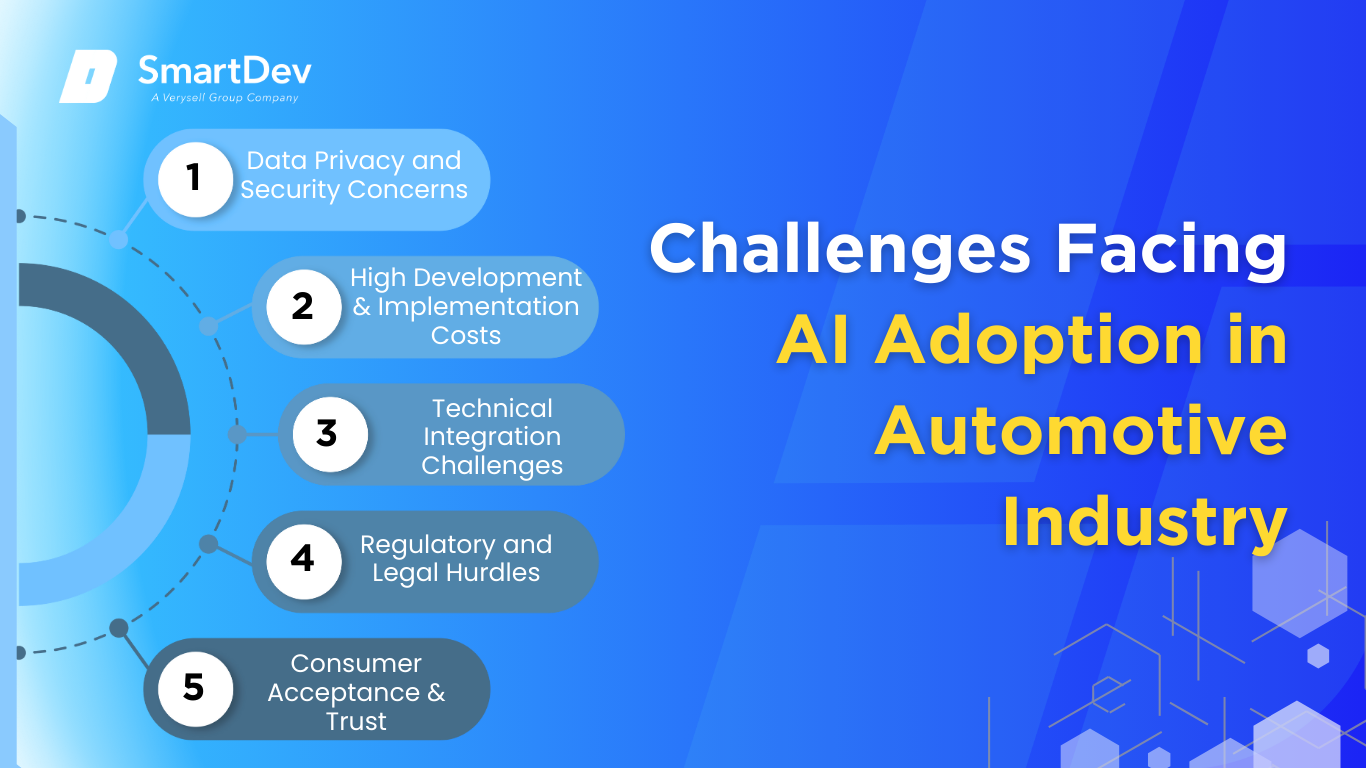
1. Data Privacy and Security Concerns
The implementation of AI in vehicles involves the collection and processing of vast amounts of data, raising concerns about data privacy and security.
Ensuring that sensitive information is protected from unauthorized access is paramount.
Automotive companies must implement robust cybersecurity measures and comply with data protection regulations to maintain consumer trust and safeguard against potential breaches.
2. High Development and Implementation Costs
Developing and integrating AI technologies into vehicles require significant investment.
The costs associated with research, development, and deployment can be prohibitive, especially for smaller manufacturers.
To mitigate these costs, companies may seek partnerships, government incentives, or adopt scalable AI solutions that can be integrated incrementally.
3. Technical Complexity and Integration Challenges
Integrating AI systems into existing vehicle architectures presents technical challenges.
Ensuring compatibility with current hardware and software, as well as achieving real-time processing capabilities, requires sophisticated engineering.
Manufacturers must invest in skilled personnel and infrastructure to overcome these integration hurdles and fully realize the benefits of AI.
4. Regulatory and Legal Hurdles
The deployment of AI in vehicles, particularly in autonomous driving, is subject to evolving regulatory frameworks.
Navigating these regulations and ensuring compliance can be complex and time-consuming.
Automotive companies must stay abreast of legal developments and engage with policymakers to shape regulations that facilitate innovation while ensuring safety and accountability.
5. Consumer Acceptance and Trust
The adoption of AI-driven features depends on consumer acceptance and trust.
Concerns about the reliability and safety of AI systems, particularly in autonomous vehicles, can hinder widespread adoption.
Building consumer confidence through transparent communication, rigorous testing, and demonstrable safety records is essential for the successful integration of AI technologies in the automotive market.
Beyond many benefits, AI have lots of challenges and the important things is that you need to have a clear and concise understanding about this adoption, from practices, challenges to ethics, you can read more at Master Ethical AI Development: The Definitive Guide.
Specific Applications of AI in Automotive Industry
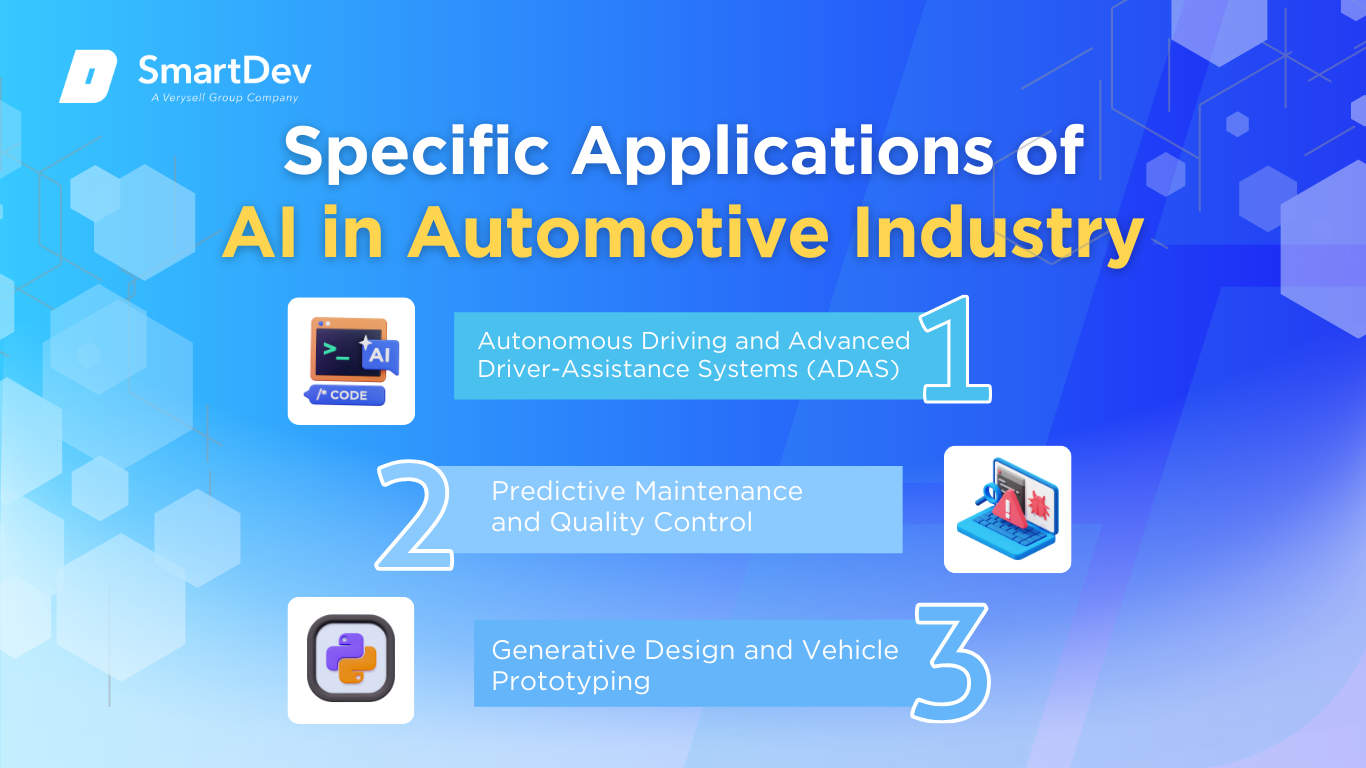
1. Autonomous Driving and Advanced Driver-Assistance Systems (ADAS)
Autonomous driving and ADAS are among the most transformative applications of AI in the automotive sector.
These systems utilize AI algorithms to process data from sensors, cameras, and radar to assist or replace human drivers.
The goal is to enhance safety, reduce accidents, and improve traffic flow.
AI-powered ADAS features include adaptive cruise control, lane-keeping assistance, and automatic emergency braking.
These systems rely on machine learning models trained on vast datasets to recognize objects, predict movements, and make real-time decisions.
Integration into vehicle systems requires robust hardware and software coordination.
The strategic value of autonomous driving lies in its potential to reduce human error, which accounts for a significant percentage of traffic accidents.
Operational benefits include increased fuel efficiency and reduced congestion.
However, challenges such as regulatory hurdles, ethical considerations, and cybersecurity risks must be addressed.
Case Study: Nissan and Wayve
Nissan partnered with AI startup Wayve to enhance its ProPILOT system, integrating AI that learns from real-world driving without relying heavily on pre-mapped data.
This collaboration aims to improve collision avoidance and adapt to diverse driving environments.
The updated system is set to launch in 2027, marking a significant step toward Level 3 autonomy.
2. Predictive Maintenance and Quality Control
Predictive maintenance leverages AI to anticipate vehicle component failures before they occur, minimizing downtime and maintenance costs.
By analyzing data from sensors and historical maintenance records,
Examples of AI in Automotive Industry
Real-World Case Studies

1. General Motors: AI-Driven Smart Manufacturing with NVIDIA Omniverse
General Motors (GM) faced the complex task of optimizing its manufacturing processes to enhance efficiency and reduce downtime.
Traditional methods lacked the flexibility and foresight needed to adapt to rapidly changing production demands and technological advancements.
To address these challenges, GM partnered with NVIDIA to integrate AI into its manufacturing operations.
Utilizing NVIDIA’s Omniverse platform, GM developed digital twins of its assembly lines, enabling virtual testing and simulation of production processes.
This approach allowed for real-time adjustments and optimization without disrupting actual manufacturing activities.
The implementation of AI-driven digital twins led to significant improvements in GM’s manufacturing efficiency.
The company experienced reduced production downtime, enhanced precision in assembly line operations, and accelerated deployment of new manufacturing strategies.
This collaboration not only streamlined GM’s production but also positioned the company at the forefront of AI-enabled automotive manufacturing.
2. Ford: Accelerating Vehicle Design with AI Agents and NVIDIA GPUs
Ford aimed to expedite its vehicle design process to keep pace with the rapidly evolving automotive market.
Traditional design methods, such as clay modeling and extensive physical simulations, were time-consuming and resource-intensive, hindering the company’s ability to innovate swiftly.
Ford integrated AI agents and leveraged NVIDIA GPUs to revolutionize its design workflow.
By employing AI models capable of generating 3D designs and conducting stress analyses, Ford transformed tasks that previously took hours into processes completed in seconds.
This technological advancement enabled rapid prototyping and iterative design, significantly reducing the time from concept to production.
The adoption of AI in Ford’s design process resulted in a dramatic decrease in development time, with certain simulations reduced from 15 hours to just 10 seconds.
This efficiency gain allowed Ford to accelerate its innovation cycle, respond more effectively to market demands, and maintain a competitive edge in vehicle design and engineering.
3. Continental: Enhancing In-Vehicle Experience with Conversational AI
Continental sought to improve the in-vehicle user experience by developing an intuitive and interactive system for drivers.
The challenge was to create a solution that allowed for natural communication between the driver and the vehicle, enhancing safety and convenience without adding complexity.
Collaborating with Google Cloud, Continental integrated conversational AI into its Smart Cockpit High-Performance Computer (HPC).
This system enabled drivers to interact with their vehicles using natural language, facilitating tasks such as navigation, vehicle control, and information retrieval through voice commands.
The implementation of conversational AI transformed the driving experience by providing a seamless and user-friendly interface.
Drivers could access information and control vehicle functions without diverting attention from the road, thereby enhancing safety and satisfaction.
This innovation positioned Continental as a leader in integrating AI to elevate in-vehicle interactions.
Innovative AI Solutions
The automotive industry is undergoing a significant transformation powered by advanced AI technologies.
These innovations not only address long-standing industry challenges—such as operational inefficiencies and safety concerns—but also unlock new opportunities in customer experience, maintenance, and fleet operations.
Below are key areas where AI is driving impactful change.
AI-Powered Fleet Management
Fleet management has become increasingly complex with the rise of connected vehicles and growing logistics demands.
AI-powered solutions are revolutionizing this space by enabling real-time decision-making and predictive insights.
Machine learning algorithms analyze live GPS data, traffic conditions, driver behavior, vehicle diagnostics, and environmental factors to recommend optimal routes, minimize fuel consumption, and anticipate maintenance needs before issues arise.
For example, predictive maintenance systems can flag anomalies in engine performance, tire pressure, or battery health—reducing breakdowns, improving safety, and lowering total cost of ownership.
Additionally, AI enhances dispatch efficiency and load optimization, enabling logistics and mobility providers to meet delivery timelines with greater precision.
Driver Monitoring Systems (DMS)
Road safety remains a top priority in automotive design, and AI-enabled Driver Monitoring Systems are a major leap forward in preventing accidents caused by human error.
These systems employ advanced computer vision, facial recognition, and deep learning models to track driver attentiveness in real time.
They can detect signs of drowsiness (e.g., frequent eye closure, head nodding), distraction (e.g., looking away from the road), or even intoxication.
Upon detecting risky behavior, the system can trigger audible alerts, seat vibrations, or even initiate vehicle control mechanisms in critical scenarios.
In semi-autonomous or autonomous driving environments, DMS acts as a crucial handover mechanism, ensuring the driver is ready to retake control when necessary.
This technology is being rapidly adopted in compliance with regulatory standards, especially in Europe and Asia.
AI in Automotive Retail
AI is also redefining the retail side of the automotive sector, creating smarter, more seamless customer journeys.
From online vehicle configurators to chatbot-powered showrooms, AI enables brands to deliver highly personalized experiences across all touchpoints.
Natural language processing and recommendation algorithms help potential buyers explore models that match their lifestyle, preferences, and budget, while virtual assistants answer queries instantly.
On the back end, AI analyzes customer data to provide dynamic financing offers, predict service needs, and suggest relevant upgrades or accessories post-purchase.
For dealerships, AI helps optimize inventory management, pricing strategies, and targeted marketing campaigns—ultimately driving higher conversions and deeper brand loyalty.
In summary, the integration of AI across various facets of the automotive industry is not only
AI-Driven Innovations Transforming Automotive Industry
The automotive industry is undergoing a significant transformation powered by advanced AI technologies.
These innovations not only address long-standing industry challenges—such as operational inefficiencies and safety concerns—but also unlock new opportunities in customer experience, maintenance, and fleet operations.
Below are key areas where AI is driving impactful change.
AI-Powered Fleet Management
Fleet management has become increasingly complex with the rise of connected vehicles and growing logistics demands.
AI-powered solutions are revolutionizing this space by enabling real-time decision-making and predictive insights.
Machine learning algorithms analyze live GPS data, traffic conditions, driver behavior, vehicle diagnostics, and environmental factors to recommend optimal routes, minimize fuel consumption, and anticipate maintenance needs before issues arise.
For example, predictive maintenance systems can flag anomalies in engine performance, tire pressure, or battery health—reducing breakdowns, improving safety, and lowering total cost of ownership.
Additionally, AI enhances dispatch efficiency and load optimization, enabling logistics and mobility providers to meet delivery timelines with greater precision.
Driver Monitoring Systems (DMS)
Road safety remains a top priority in automotive design, and AI-enabled Driver Monitoring Systems are a major leap forward in preventing accidents caused by human error.
These systems employ advanced computer vision, facial recognition, and deep learning models to track driver attentiveness in real time.
They can detect signs of drowsiness (e.g., frequent eye closure, head nodding), distraction (e.g., looking away from the road), or even intoxication.
Upon detecting risky behavior, the system can trigger audible alerts, seat vibrations, or even initiate vehicle control mechanisms in critical scenarios.
In semi-autonomous or autonomous driving environments, DMS acts as a crucial handover mechanism, ensuring the driver is ready to retake control when necessary.
This technology is being rapidly adopted in compliance with regulatory standards, especially in Europe and Asia.
AI in Automotive Retail
AI is also redefining the retail side of the automotive sector, creating smarter, more seamless customer journeys.
From online vehicle configurators to chatbot-powered showrooms, AI enables brands to deliver highly personalized experiences across all touchpoints.
Natural language processing and recommendation algorithms help potential buyers explore models that match their lifestyle, preferences, and budget, while virtual assistants answer queries instantly.
On the back end, AI analyzes customer data to provide dynamic financing offers, predict service needs, and suggest relevant upgrades or accessories post-purchase.
For dealerships, AI helps optimize inventory management, pricing strategies, and targeted marketing campaigns—ultimately driving higher conversions and deeper brand loyalty.
In summary, the integration of AI across various facets of the automotive industry is not only
How to Implement AI in Automotive Industry
Successfully adopting AI in the automotive sector requires a strategic, phased approach.
The following steps outline how companies can transition from exploration to full-scale implementation while maximizing value and minimizing risk.
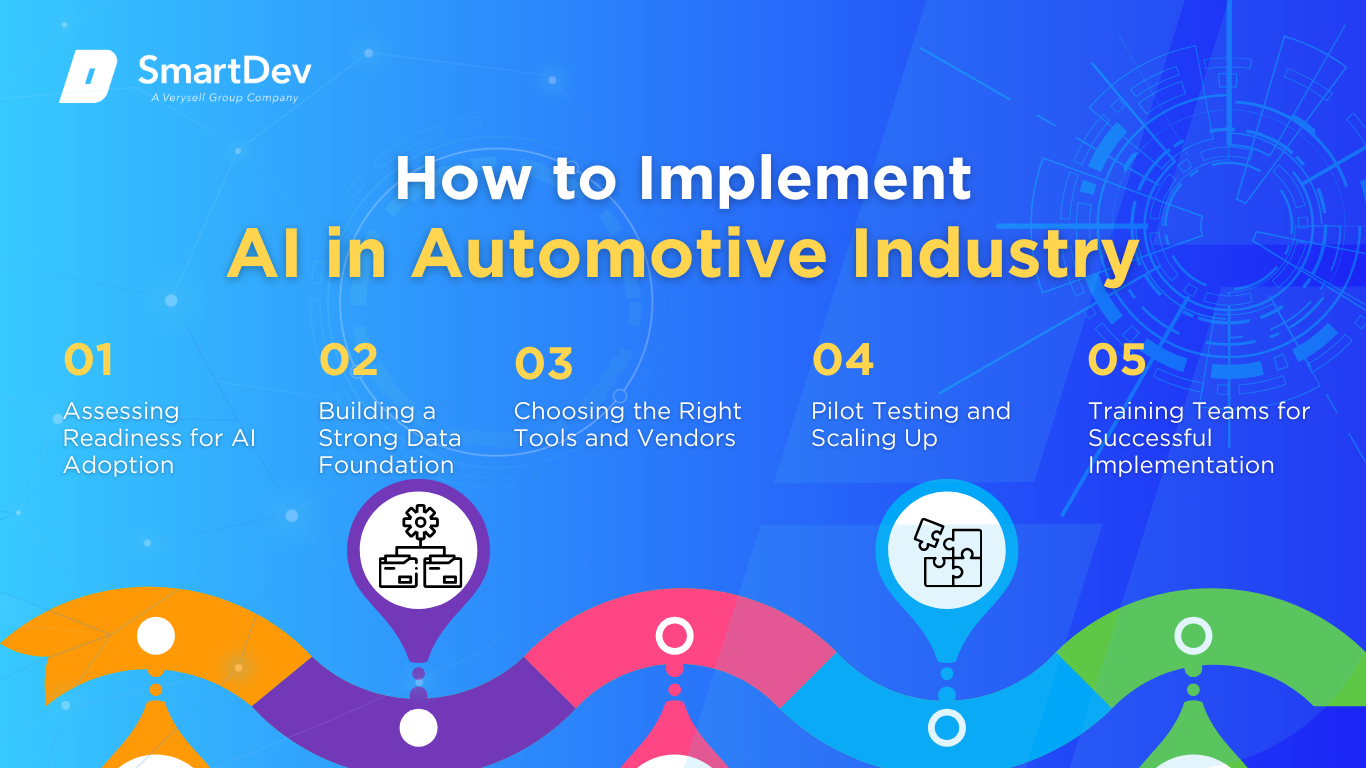
1. Assessing Readiness for AI Adoption
Before integrating AI technologies, automotive companies must evaluate their readiness across several dimensions.
This includes assessing current operational workflows, digital infrastructure, data availability, and employee familiarity with digital tools.
Identifying specific high-impact areas—such as design optimization, predictive maintenance, production automation, or customer engagement—helps set clear priorities and expectations for AI adoption.
A thorough readiness audit provides a strategic foundation for informed decision-making and smooth implementation.
2. Building a Strong Data Foundation
A successful AI strategy starts with high-quality data.
Automotive firms need to establish a centralized, secure, and scalable data infrastructure capable of ingesting and managing data from multiple sources—including IoT sensors, vehicle telematics, CRM systems, and manufacturing processes.
Data must be cleaned, standardized, and continuously updated to train accurate AI models.
In parallel, strong data governance, privacy controls, and cybersecurity protocols are essential to ensure regulatory compliance and build stakeholder trust.
3. Choosing the Right Tools and Vendors
Selecting the right mix of AI tools and technology partners is crucial.
Automotive companies should look for platforms that are scalable, compatible with existing systems, and tailored to industry-specific needs such as robotics, computer vision, or digital twins.
Collaborating with AI-focused companies like Nvidia or OpenAI can accelerate deployment and unlock advanced capabilities.
Long-term vendor support, integration flexibility, and a proven track record in the automotive sector should guide the selection process.
4. Pilot Testing and Scaling Up
AI implementation should begin with pilot programs that target specific, measurable objectives.
Pilots help organizations validate their hypotheses, fine-tune data models, and identify potential risks or process gaps early.
Once initial projects demonstrate positive results, companies can develop a roadmap to scale AI applications across different departments, such as production, logistics, and customer service.
A phased rollout ensures better change management and maximizes return on investment.
5. Training Teams for Successful Implementation
Upskilling employees is key to ensuring the successful integration of AI solutions.
Teams must understand both the capabilities and limitations of AI tools to collaborate effectively with them.
Organizations should offer ongoing training, workshops, and hands-on sessions tailored to different roles—from engineers and analysts to line operators and customer service staff.
Fostering a culture of innovation and openness to change enables the organization to evolve alongside the technology and adapt to future advancements.
AI is revolutionizing the automotive industry—from smart manufacturing and real-time diagnostics to personalized customer interactions.
Get in touch with our team to explore tailored AI solutions that boost efficiency, spark innovation, and empower data-driven decisions across your automotive operations.
Measuring the ROI of AI in Automotive Industry
Key Metrics to Track Success
To evaluate the return on investment (ROI) of AI initiatives, automotive companies should monitor metrics such as productivity improvements, cost savings from automation, and enhancements in product quality.
For instance, Ford’s use of AI agents and Nvidia GPUs has accelerated vehicle design processes, reducing time-consuming tasks and improving efficiency.
Case Studies Demonstrating ROI
Leading automotive companies are realizing measurable returns on investment (ROI) by deploying AI across design, operations, and customer service.
The following case studies highlight how AI is transforming key business functions, driving efficiency, and improving customer outcomes.
1. Ford’s AI-Driven Design Process
Ford Motor Company has embraced AI to accelerate its vehicle design and development processes.
Leveraging AI agents supported by high-performance Nvidia GPUs, Ford has been able to simulate, test, and refine designs in a fraction of the time traditional methods require.
This integration allows engineers to explore more design options in parallel, reduce physical prototyping costs, and bring new models to market faster.
As a result, Ford not only cuts down development cycles but also boosts its agility and responsiveness to consumer demands—delivering both cost savings and strategic advantage in an increasingly competitive automotive market.
2. BMW’s Generative AI Platform
In collaboration with Accenture, BMW launched a generative AI platform to support business decision-making across its North American operations.
The platform analyzes large volumes of structured and unstructured data from various internal and external sources to generate actionable insights for departments ranging from logistics and finance to customer experience.
By automating repetitive analytical tasks and enhancing forecasting accuracy, the system has significantly improved operational productivity.
BMW also reports improvements in customer engagement due to more personalized and data-informed touchpoints—demonstrating how AI can deliver both efficiency and customer-centric outcomes simultaneously.
3. UVeye’s Automated Vehicle Inspection
UVeye has introduced an AI-powered vehicle inspection system that revolutionizes the traditional inspection process.
Deployed at Carl Black Chevrolet in the U.S., the system uses computer vision and deep learning to scan a vehicle’s exterior and undercarriage in under 30 seconds.
It can detect issues such as tire wear, oil leaks, and body damage with high precision, eliminating the need for manual checks.
This not only reduces labor costs and inspection times but also increases transparency and trust with customers by providing real-time, visual reports.
The adoption of UVeye’s technology has led to higher customer satisfaction scores and improved service throughput for the dealership.
Common Pitfalls and How to Avoid Them
Implementing AI comes with challenges such as data privacy concerns, lack of skilled personnel, and integration complexities.
To mitigate these risks, companies should establish clear data governance policies, invest in employee training, and choose AI solutions that align with their existing infrastructure and business goals.
Measuring ROI from AI initiatives can be challenging for many businesses and institutions due to varying costs, goals, and levels of readiness.
If you’re looking to explore this topic in depth, check out AI Return on Investment (ROI): Unlocking the True Value of Artificial Intelligence for Your Business.
Future Trends of AI in Automotive Industry
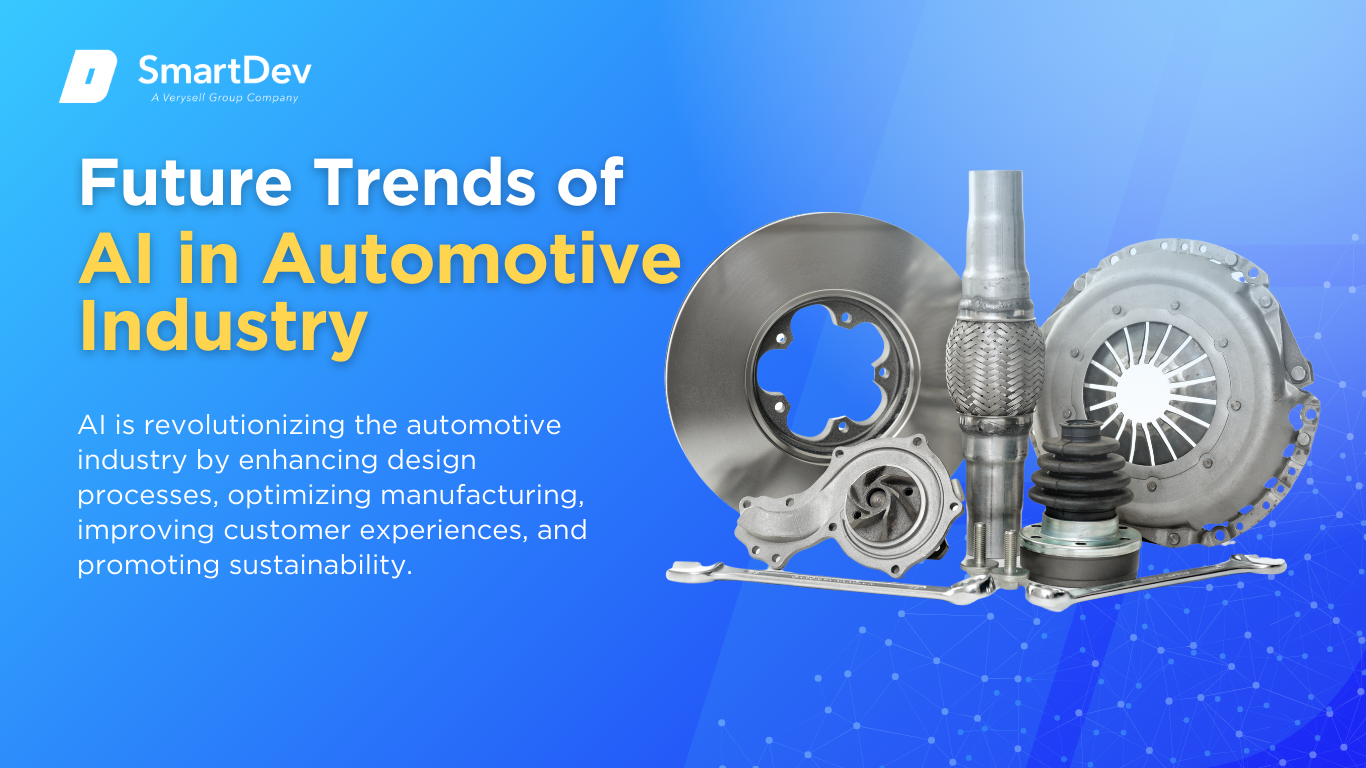
Predictions for the Next Decade
The next decade will witness AI becoming integral to autonomous driving, personalized customer experiences, and sustainable manufacturing.
The AI in automotive market is projected to reach USD 186.4 billion by 2034, growing at a CAGR of 42.80%.
Innovations like AI-driven virtual assistants and predictive maintenance will become standard features in vehicles.
How Businesses Can Stay Ahead of the Curve
To remain competitive, automotive companies should continuously invest in AI research and development, foster partnerships with tech firms, and stay abreast of regulatory changes.
Embracing a proactive approach to AI adoption will enable businesses to lead in innovation and customer satisfaction.
Conclusion
Key Takeaways
AI is revolutionizing the automotive industry by enhancing design processes, optimizing manufacturing, improving customer experiences, and promoting sustainability.
Real-world applications demonstrate significant ROI, with companies like Ford and BMW leading the way in AI integration.
Moving Forward: A Path to Progress
Automotive companies must embrace the transformative potential of AI by taking strategic, forward-looking steps toward adoption.
By evaluating their readiness, strengthening data infrastructure, choosing the right technologies, and upskilling their workforce, they can unlock AI’s full potential—driving innovation, boosting operational efficiency, and accelerating growth in a rapidly evolving industry.
Ready to explore how AI can reshape your automotive operations? Contact our team today to discover tailored AI solutions that align with your business goals and fuel long-term success.
—



